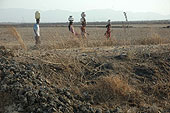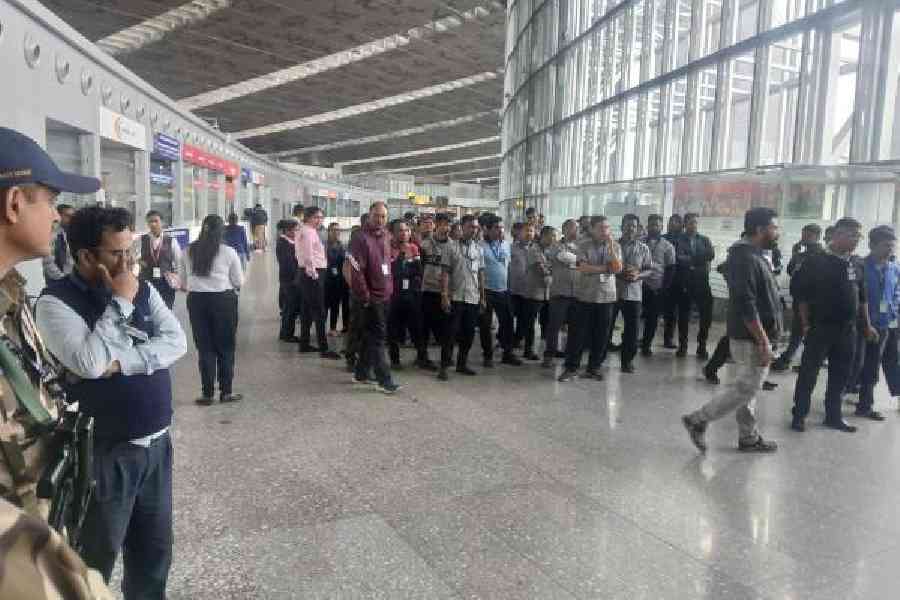 |
 |
| LAND OF GOLD: (Top) The fertile fields of Pen; (above) Angry Narvel villagers (left to right) Chandrakanth Mhatre, Amarchand Mhatre, Govardhan Patil and Kiran Mhatre (Pictures: Gajanan Dudhalkar) |
Over a meal of spicy rahu and rice, within kissing distance of the sea, an uprising is on the boil in Maharashtra’s Raigad district that threatens to turn Nandigram into a footnote. The venue is a farmer’s house and the villagers have gathered over a meal after sunset to voice their protest. Those scripting the plan are the farmers-cum-fishermen of the Pen taluka in Raigad, the state’s rice bowl, where a Special Economic Zone (SEZ) is scheduled to be set up, if Reliance Industries Ltd and the state government have their way.
The SEZ was originally meant to cover 14,000 hectares, but will now have to be scaled down to 5,000 hectares in line with the central government’s new SEZ policy. In Pen, as in the 45 villages resisting acquisition for the government brokered-SEZ, swords are being sharpened.
The old (like 70-year-old Dahanu Shankar Mhatre, the patriarch of Narvel village in Pen) have joined the fight, as have women and the young. Banubai, a resident of Malegharwadi village, is in a belligerent mood, ready to greet anybody seeking to take her land away with the tall iron rod that she uses for tilling. “This land that the government is stealing from the hands of the farmer in the name of progress is like gold,” says Kiran More, a young man with a landholding of 1.5 acres.
Right now, people may not have the kind of hard cash that the SEZ tempts them with, but it’s still a life of plenty in Pen. “I can feed my 20-member family, even though none of us holds steady jobs,” says Amarchand, a Narvel farmer who owns three acres of farmland in a region where the average landholding is 1.5 acres.
In fact, Mhatre’s house with paddy stored in wide, cylindrical tins is only a specimen of what most houses are like. The stored grain is enough to last the year, even after selling a portion in the market. A quintal of rice fetches Rs 600, and an acre yields an average of 21 quintals.
 |
Half the farming community doubles up as fishermen. So food is never in short supply. Ramchandra Bhoir, another village elder living in Pen’s seafront village, Janaveli, has just set out in his boat across the creek to swirl his net for a bounty of the freshest catch. His catch fetches him an average income of Rs 500-600 a day, says Govardhan Patil, a young farmer and fisherman in Pen.
The administration, however, is anything but worried about farmers launching an agitation. Police superintendent Rajkumar Watkar refuses to believe that there is any cause for worry. “At the most, the people will stage a rasta roko, chuck stones or block the way of government officials,” he says. A Reliance official declined to comment on any opposition to the land acquisition.
In Raigad, land acquisition has been a dirty word from the days of the British. Yet there are also villagers who accept acquisition as a way of moving on. Many of the young men are known to be agents for the developer. “If you have muscle power and the gift of the gab in the right combination, you could get paid between Rs 3,000 and Rs 15,000,” says Vaishali Patil, a land rights activist in Raigad.
Many of the absentee landlords — people living in cities who have land in the region — are also selling out to the SEZ. The villagers complain that some residents are selling other people’s land, faking identities. Patil believes that some 54 fake transactions have taken place in Pen.
Complaints have been lodged with the police, but so far only one FIR has been registered. People now view government assurances with suspicion. Chief minister Vilasrao Deshmukh’s declarations about pulling out of the SEZ land acquisition tangle are empty words, as are the tehsildar’s orders to stamp farmers’ documents with a seal that declares their land as irrigated.
At the land acquisition office, it’s business as usual. On April 14, a state holiday, the latest batch of farmers from Benavale, Narvel and Bahiramkotak villages in Pen were summoned for a land acquisition hearing. Clearly, the process of acquisition by the state government is on despite all the promises. Several well-substantiated objections to the SEZ in this region, raised by the Raigad district level irrigation department are compelling.
In January this year, in a letter to the acquisition department, the irrigation department stated that 22 of the 52 villages in Pen taluka to be sacrificed to the SEZ were actually earmarked for irrigation under the Hetawane Dam Irrigation Project, 1988. These 22 cultivable villages, it added, formed 3,100 hectares of the total 6,668 hectares to be benefited by the dam.
If the 3,100 hectares are handed over to the SEZ, the cost of irrigating new land would be Rs 68.34 crore, says the letter. Given the pressure that this would put on the state exchequer, the developer must be asked to foot the bill, it suggests. Like the irrigation department, the people of Pen pin their hopes on the waters of the Hetawane dam to green their valley.
The government holds that the SEZ would benefit people like Amarchand Mhatre, but he will have none of it. “Many of our relatives who grew up in the village have become doctors and lawyers or joined the police. What development is the government talking about,” asks Mhatre. The government’s definition of development scares the villagers for another reason. If the SEZ does become a reality here, “the area will be exempted from octroi and customs clearance,” says Patil.
Several years ago, it was here, along the Raigad coast at Shreevardhan, that a consignment of deadly RDX was offloaded, to be used in the Mumbai blasts of 1993. The situation, the villagers hold, is explosive. And they mean that in more ways than one.










